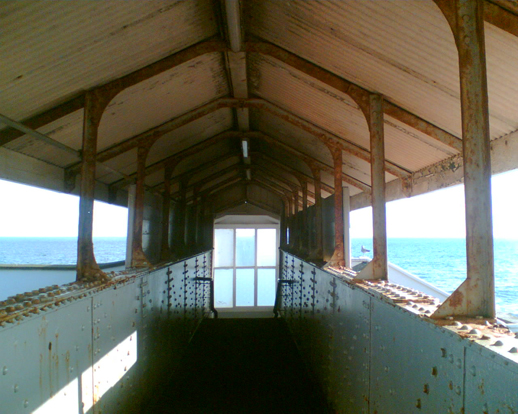In which, as the year comes to its end, our friends and collaborators look back and share their moments:
“Bonaparte’s on groyne two!?” Wow, could it be true? The scene is Dawlish Warren in south Devon – at the landward end of a spit of sand and dunes jutting out at the mouth of the Exe estuary. It’s terrain full of wonder. Just to the north the mainline railway runs exhilaratingly close to the sea, on through the kind of beautifully blasted station infrastructure seen above. A pre-fame Tommy Cooper sold ice creams hereabouts, in among the holiday camps and slot machines that today sit alongside Dawlish Warren Nature Reserve. There are other more recent comedic links. David Quantick had a Saturday job at the Royal Marine training centre just up the estuary. Young Dave polished the floors and restocked Britvic orange at the military establishment served by the rail station with the best name in the whole damned land – Lympstone Commando. But what about that Bonaparte’s on groyne two? Fear not passing UKIP ramblers. The Emperor of the French, King of Italy, Protector of the Confederation of the Rhine, Mediator of the Helvetic Confederation, isn’t about to enforce increased Euro-federalisation from beyond the grave. Even a part-time birdwatcher like me knows that a Bonaparte’s gull is a rare vagrant visitor to Britain, a species more at home on the North American seaboard. Hey hosanna.
A glance at the exactingly compiled Collins Bird Guide will tell you the Bonaparte’s gull is something a little extraordinary. The Collins Guide is by Lars Svensson, Dan Zetterström, Peter J Grant and Killian Mullarney. As nature writers and artists go this is a pretty rock-music assembly of names – suggesting Metallica, a bird-world answer to Pink Floyd sleeve artist Storm Thorgerson and a Led Zeppelin manager come back from the dead to write about buntings and bustards. Plus, perhaps, a passing virtuoso on the Uilleann pipes. The Collins Bird Guide isn’t given to over-excitement. But, when offering advice on identification of the Bonaparte’s gull, the book features a rare exclamation mark: “Beware of [confusion with] first-summer black-headed gull with faded and translucent primaries!”
Left to my own devices I’d never have spotted the Bonaparte’s. I’d read about its arrival on the excellent local bird-sightings webpage. But even then I’d almost certainly never have tracked the bird down. Luckily I had it pointed out to me by Rob and Cath, a friendly and on-it couple down from the West Midlands. The Bonaparte’s was “confiding”, as the birding jargon has it. The gull was in situ for ages, flicking on and off the maritime woodwork, giving clear views of its tern-like delicacy. This was my kind of nature-detection. Two pints and a big baked potato in the dune-side Boathouse Tavern. Then out into the wind and sunlight to see something I’ve never seen before and will, chances are, never see again. A brilliant dash of white coming effortlessly into sight, the avian equivalent of a fifty-pound note blowing toward you along the pavement. As the song has it, “Holding on to something / And not knowing exactly what you’re waiting for.”
Beyond seagulls the best extra-familial memories that come to mind from 2012 involve pop music in astonishing settings. While hoping not to get too inbred, a fair few of these were connected with Caught by the River. As with previous years, the Caught by the River stage at Cornwall’s Port Eliot Festival was a remarkable thing – the world’s most enlightened rave-mod herberts being allowed to enact glorious cultural miscegenation down by riverine Cornwall’s prettiest tidal expanses. From 2012 there’s an abiding memory of the close of Cate Le Bon’s performance – Bonzo to her most devoted admirers. Cate closed her set at the CBTR stage with some imperious, wonderstruck poses. Here, it seemed, was distaff rock divinity – full of volume and drama but also amounting to a glorious female inverse of the esteemed male piggery of Zep’s own Bonzo. At 8am in the morning you could return to the riverbank. There, an expert oarsman was waiting to take you out in Canadian canoes for an hour – out on to meditatively still waters, under a warm rising sun. Oh what a mixture – a stately home with the doors wide open; counterculture and canoe-culture there for whoever wanted it. They weren’t running the show for free, but the price of admission was no more than the festival norm and for that you really ended up somewhere else.
Astonishingly, another Caught by the River stage at another festival raised the level of rock-in-arcadia amazement even higher. The all-new Festival No.6 took place at Portmeirion in north Wales, the remarkable folly-in-extremis created by the late architect Bertram Clough William-Ellis – the Italianate seaside village that became the backdrop for The Prisoner on the television. At Festival No.6 the Estuary Stage was hosted by Caught by the River and the Faber Social. The view from the stage took you out across Cardigan Bay, over to the sunlit hills of the Lleyn peninsula. It filled you with joyous disbelief: “Is this some kind of joke? How did this get here? How did I get here?” Inland New Order did their bit, alongside, among others, Maxine Peake, Richard Hawley and The Brythoniaid Welsh Male Choir. Wow.
As a mere dilettante in the worlds of birdwatching and rock organisation, I find myself full of admiration for anyone who can detect a Bonaparte gull in a place where it really shouldn’t be – or someone who can bring Spiritualized, Mersey Swing’s social-dancing class, a Dave Beer DJ set plus sufficient site hoarding to an amazing outpost in north Wales. Port Eliot Festival is having a year off in 2012. Festival No.6 is set to return to Portmeirion next September. It really is worth a trip.
